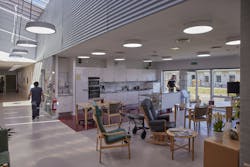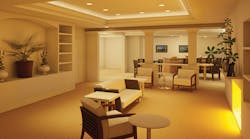Circadian lighting could help dementia residents...if staff can operate it
With personalized circadian lighting systems just about ready in individual rooms at a Danish nursing home, a European Union–backed consortium has initiated two research projects at the site, including one that studies the technology’s acceptance and usability by the caregivers who operate it.
The other examines the lighting’s effect on the health of residents, many of whom have dementia.
Circadian lighting is tunable to mimic the spectral content and intensity of the sun over the course of a day, helping to balance human circadian rhythms and thus fostering health and wellbeing, including improved sleep cycles.
The Bauneparken nursing home in Skaevinge is outfitting 22 rooms with separate tunable spectra and intensity, which is 6 more rooms than first announced last year at the project's inception.
The €1.2 million initiative aims to ascertain the benefits of tailoring circadian lighting to individuals, as opposed to a one-size-fits-all approach. It goes by the name PerCiLight,or Personalized and Circadian active dynamic Lighting.
PerCiLight is also looking at the acceptance of the technology by the care staff, who are the users responsible for operating the lighting in the rooms and who vary widely in experience, age, roles, education, and the time of day they work.
For that purpose, the consortium has tapped a specialist in technology acceptance studies from Denmark’s Aalborg University, associate professor Thomas Bjørner.
“The purpose of our study is twofold,” Bjørner said in a release issued by Denmark’s Chromaviso, the company providing the lighting system. “On the one hand, we look at the wellbeing of the employees and whether light intervention improves their quality of life. On the other hand, we examine technology acceptance, user involvement, and the usability of the new innovative technology.”
Bjørner’s background includes technology acceptance studies in television and other media. He has also examined both gaming and virtual reality as learning tools.
“We need to listen much more to what users have to say along the way, so that we can better understand how users comprehend the system and use it,” he said. He emphasized the importance of training the staff in how to operate the lighting. It should help that staff members provided input on the system’s interface during development.
To study the effect on residents, PerCiLight has hired Elisabeth Flo-Groeneboom, a clinical psychology professor at the University of Bergen in Norway. Her background includes studying the effect of light on dementia sufferers.
“We have reached a point where we actually have the technology available that can be personalized, is flexible, and is adaptable,” Flo-Groeneboom said. “Therefore, it will be extremely interesting to see how it affects the nursing home residents. Light is not just light. Research shows that the timing of the right type of light and darkness at the right time is crucial for our circadian rhythm and sleep. Now we have taken the technology to the next level and can actively use it in the demanding care environment.”
Her team is looking at circadian lighting’s effect on sleep, depression, and overall mental health.
They are initially collecting data from the residents’ use of “normal” lighting, followed by data collection once Chromaviso’s Chroma Zenit lighting goes into full operation on the premises.
“Additionally, [the study organizers] take into account the seasons and natural light in the study and therefore conduct follow-up studies throughout the year,” a Chromaviso spokesperson said. “The study includes a group of residents who receive the light intervention in their apartments and common areas and a corresponding control group who do not have the light intervention in their apartments.”
Prior to the PerCiLight project, Chromaviso had installed circadian lighting in common areas of the nursing home, which is located about 25 miles northwest of Copenhagen.
Other partners in PerCiLight include two Wroclaw, Poland–based companies, Antologic and Grinn. They are furnishing IoT technology to help monitor conditions and reactions. Hellerup, Denmark–based Schmelling* and Zurich, Switzerland–based lightsphere are providing lighting design.
The E.U. is funding about two thirds of the €1.2 million budget through its Active Assisted Living Programme Ageing Well in the Digital World scheme (AAL).
MARK HALPER is a contributing editor for LEDs Magazine, and an energy, technology, and business journalist ([email protected]).
Follow our LinkedIn page for our latest news updates, contributed articles, and commentary, and our Facebook page for events announcements and more. You can also find us on Twitter.

Mark Halper | Contributing Editor, LEDs Magazine, and Business/Energy/Technology Journalist
Mark Halper is a freelance business, technology, and science journalist who covers everything from media moguls to subatomic particles. Halper has written from locations around the world for TIME Magazine, Fortune, Forbes, the New York Times, the Financial Times, the Guardian, CBS, Wired, and many others. A US citizen living in Britain, he cut his journalism teeth cutting and pasting copy for an English-language daily newspaper in Mexico City. Halper has a BA in history from Cornell University.








![The DesignLights Consortium continues to make progress in shifting outdoor lighting products and implementation practices toward a more restrained and thoughtful strategy. [Image does not represent a DLC qualified fixture.] The DesignLights Consortium continues to make progress in shifting outdoor lighting products and implementation practices toward a more restrained and thoughtful strategy. [Image does not represent a DLC qualified fixture.]](https://img.ledsmagazine.com/files/base/ebm/leds/image/2024/08/66be810888ae93f656446f61-dreamstime_m_265700653.png?auto=format,compress&fit=&q=45&h=139&height=139&w=250&width=250)
